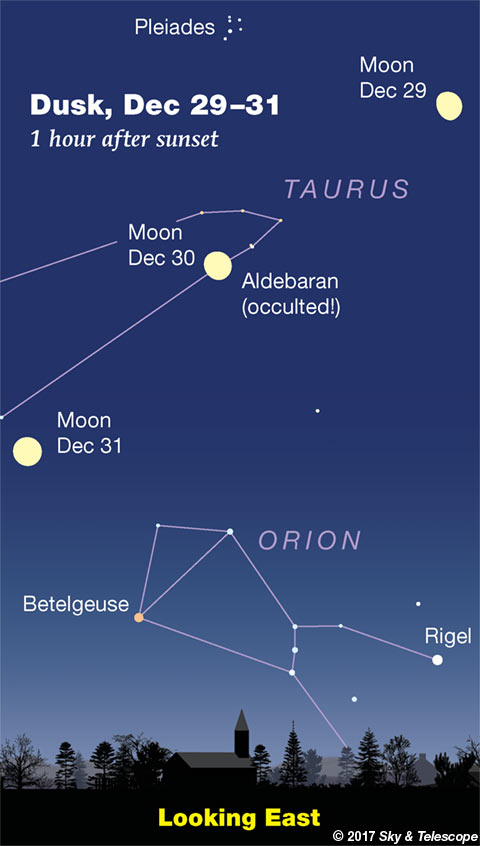
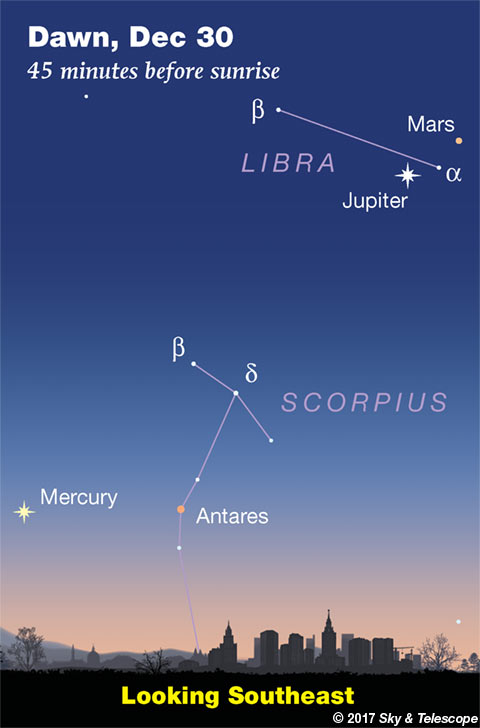
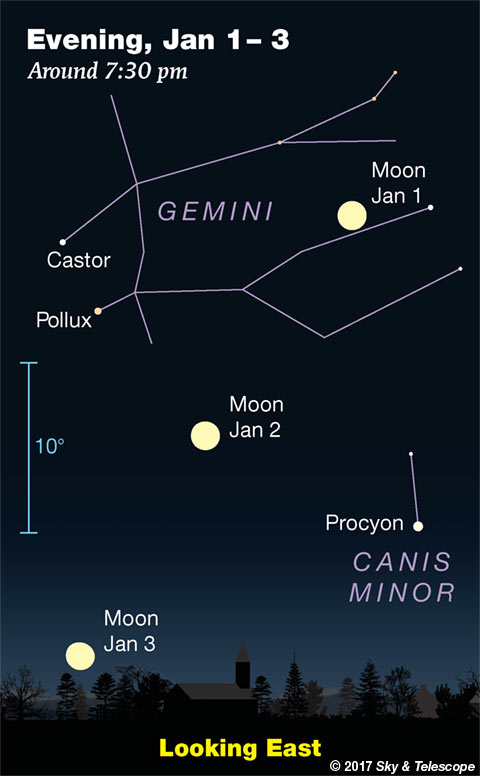
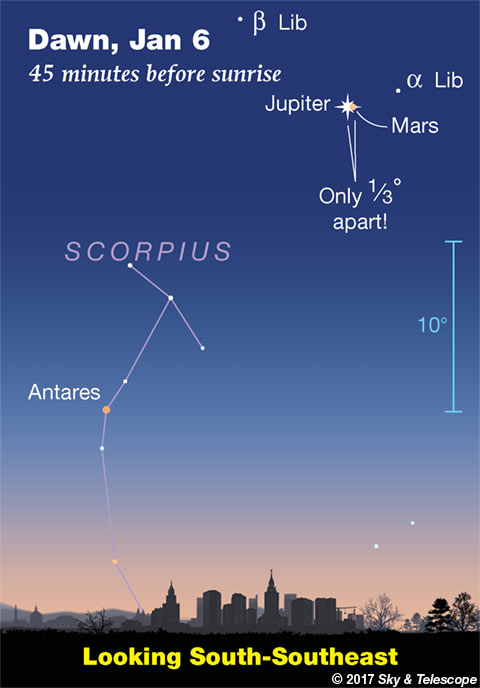
Friday, December 29
• This evening, look lower left of the waxing gibbous Moon for Aldebaran, and upper left of the Moon for the Pleiades.
• Mercury should be an easy catch now low in the dawn. Look for it far lower left of Jupiter, as shown in the second scene here. (The illustration exaggerates their visibility as dawn grows bright. Binoculars will help if you're not out quite soon enough!)
Saturday, December 30
• Watch the Moon pull eastward away from Aldebaran through the night.
If you're in the eastern US, the Moon occults Aldebaran early this evening. In northern Europe the occultation happens very late at night. Here are a map and local timetables, with the times of the star's disappearance (on the Moon's very slender dark limb) and its reappearance (on the bright limb) for many locations. Also in the tables are the altitudes of the Moon and Sun at those times. (Note that the text consists of three separate, long tables: for the star's disappearance, for its reappearance, and the locations of the cities.) With the Moon so bright, use a telescope to follow the star through the lunar glare.
Sunday, December 31
• After the noise and cheering at the turn of midnight tonight, step outside into the silent, cold dark. Orion stands beneath the high moon. To Orion’s lower left, Sirius sparkles at its peak height in the south. Upper left of Sirius is Procyon. And way around to the northeast, the Big Dipper is standing high on its handle, as if this were already the beginning of spring.
Monday, January 1
• Full Moon (exact at 9:24 p.m. EST). This is an especially super "supermoon"; the Moon happens to be at its closest perigee of the year. Still, the difference in size and brightness between this and the average full Moon is pretty slight; the Moon appears only 7% larger in diameter than average (but 14% wider than at a "minimoon," its most distant). Can you really detect the difference by careful looking? Only if you've examined the Moon's size carefully on many other occasions.
The moon is shining in the feet of Gemini, with Pollux and Castor to its left in the evening and Betelgeuse in Orion to its right.
Tuesday, January 2
• The Moon, a day past full, forms a curving line this evening with Castor and Pollux to its upper left and Procyon to its lower right. Farther to the right is Orion.
Wednesday, January 3
• Once the Moon rises in early evening, it forms a big, almost equilateral triangle with Pollux above it and Procyon to its upper right. A little above Pollux is Castor, slightly fainter.
• The Quadrantid meteor shower should reach its brief peak late tonight, well-timed for North America. But the floodlight of the waning gibbous Moon in the sky will hide all but the brightest of the Quads.
Thursday, January 4
• When the waning gibbous Moon rises late this evening, it's accompanied by Regulus in Leo (for North America). Watch the Moon slide past Regulus through the rest of the night. The Moon occults Regulus for parts of northern Canada and Alaska; map and timetables.
Friday, January 5
• Orion strides boldly up the southeastern sky after nightfall this month. Above it glitters orange Aldebaran, 65 light-years away. Above Aldebaran are the Pleiades, about 435 light-years away. Far left of Aldebaran and the Pleiades, brilliant Capella shines from a distance of 42 light-years.
• Just before or during early dawn on Saturday morning the 6th, spot bright Jupiter in the south-southeast. Fainter Mars is barely to its right, by just 1/3° — less than the width of a chopstick at arm’s length. The two planets will fit in a medium-power eyepiece view, but both are near their maximum distances from Earth and about as small as they ever look. Mars is especially tiny.
Saturday, January 6
• Vega still twinkles low in the northwest as night falls. It’s sometimes called the Summer Star, but it’s way out of season. It’ll soon be gone, to return next spring.
• Just before or during early dawn on Sunday the 7th, again spot bright Jupiter in the south-southeast. Mars is now 1/3° below it (at the times of dawn for North America). Nearby is Alpha (α) Librae, a very wide double star for binoculars.
________________________
Want to become a better astronomer? Learn your way around the constellations! They're the key to locating everything fainter and deeper to hunt with binoculars or a telescope.
This is an outdoor nature hobby. For an easy-to-use constellation guide covering the whole evening sky, use the big monthly map in the center of each issue of Sky & Telescope, the essential guide to astronomy.

Once you get a telescope, to put it to good use you'll need a detailed, large-scale sky atlas (set of charts). The basic standard is the Pocket Sky Atlas (in either the original or Jumbo Edition), which shows stars to magnitude 7.6.
Next up is the larger and deeper Sky Atlas 2000.0, plotting stars to magnitude 8.5; nearly three times as many. The next up, once you know your way around, is the even larger Uranometria 2000.0 (stars to magnitude 9.75). And read how to use sky charts with a telescope.
You'll also want a good deep-sky guidebook, such as Sue French's Deep-Sky Wonders collection (which includes its own charts), Sky Atlas 2000.0 Companion by Strong and Sinnott, or the bigger Night Sky Observer's Guide by Kepple and Sanner.
Can a computerized telescope replace charts? Not for beginners, I don't think, and not on mounts and tripods that are less than top-quality mechanically (meaning heavy and expensive). And as Terence Dickinson and Alan Dyer say in their Backyard Astronomer's Guide, "A full appreciation of the universe cannot come without developing the skills to find things in the sky and understanding how the sky works. This knowledge comes only by spending time under the stars with star maps in hand."
This Week's Planet Roundup
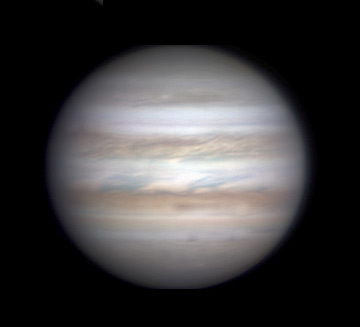
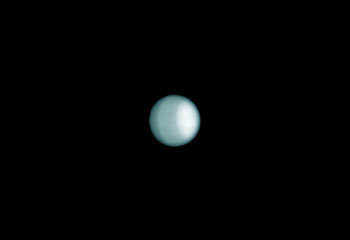
Mercury (magnitude –0.3) is entering a fine morning apparition. Look for it low in the southeast in early dawn, very far lower left of Jupiter and Mars. Don't confuse Mercury with fainter, twinklier Antares about 10° to its right or upper right.
Venus and Saturn remain hidden behind the glare of the Sun.
Mars and Jupiter (magnitudes +1.5, and –1.8, respectively) rise in the east-southeast around 3 a.m. and are well up in the south-southeast in early dawn. Jupiter is the brightest point in the sky. Mars begins the week 3½° to Jupiter's upper right and draws closer to it every day. They have a close conjunction, just 0.3° apart, on the mornings of January 6th and 7th.
In their background is 3rd-magnitude Alpha (α) Librae, a very wide double star for binoculars.
Uranus (magnitude 5.8, in Pisces) and Neptune (magnitude 7.9, in Aquarius) are best hunted right after dark — when Uranus is high in the south-southeast and Neptune hasn't yet sunk too low in the southwest. Use our finder charts online or in the October Sky & Telescope, page 50.
______________________
All descriptions that relate to your horizon — including the words up, down, right, and left — are written for the world's mid-northern latitudes. Descriptions that also depend on longitude (mainly Moon positions) are for North America.
Eastern Standard Time (EST) is Universal Time (also called UT, UTC, GMT, or Z time) minus 5 hours.
______________________
"Science is built up of facts, as a house is with stones. But a collection of facts is no more a science than a heap of stones is a house."
— Henri Poincaré (1854–1912)
______________________
"The dangers of not thinking clearly are much greater now than ever before. It's not that there's something new in our way of thinking, it's that credulous and confused thinking can be much more lethal in ways it was never before."
— Carl Sagan, 1996
______________________
"Objective reality exists. Facts are often determinable. Vaccines save lives. Carbon dioxide warms the globe. Bacteria evolve to thwart antibiotics, because evolution. Science and reason are not fake news, not a liberal conspiracy. Civilization's survival depends on our ability, and willingness, to use them."
— Alan MacRobert, your Sky at a Glance editor
______________________
"Facts are stubborn things."
— John Adams, 1770
 0
0








Comments
You must be logged in to post a comment.